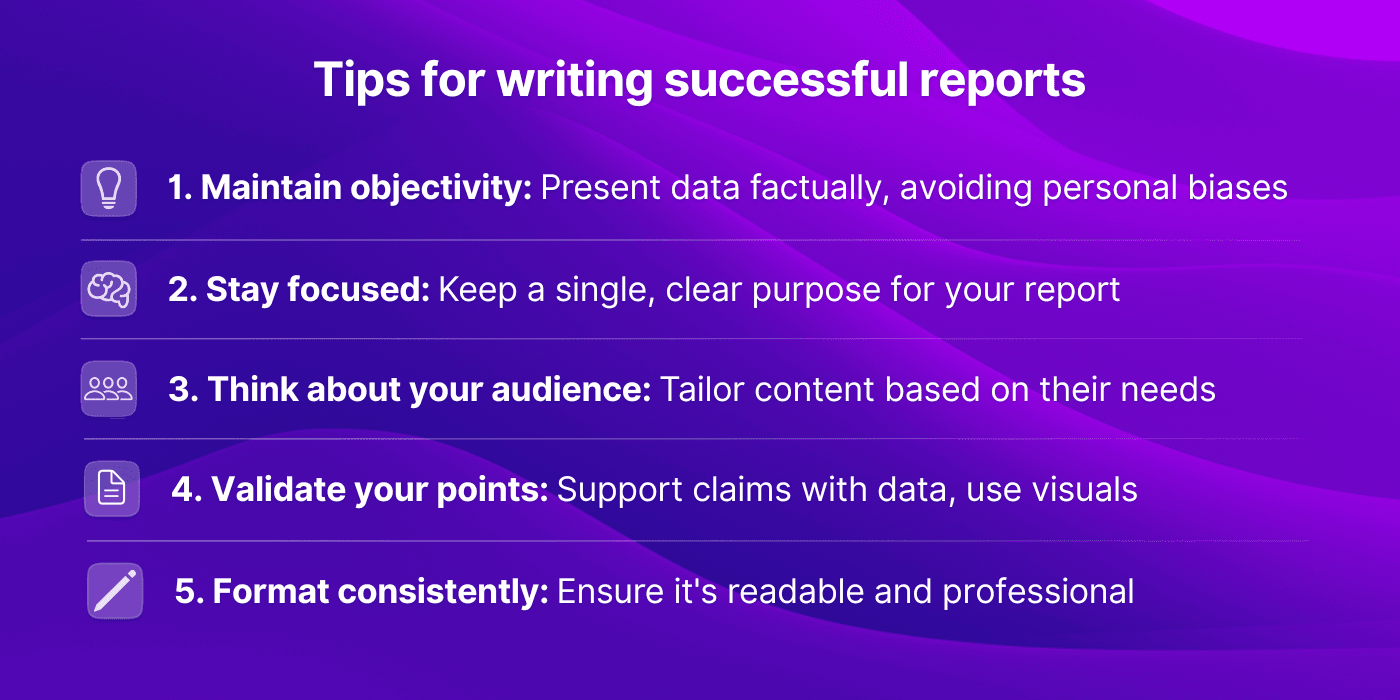
How to write a report (with tips and examples)
Delve into our practical guide designed to improve your report writing skills. Explore example reports and discover useful tips for writing clear and effective reports.

1. Understand Your Purpose: Always start with a clear understanding of your report's objective. This clarity guides your research, the writing process, and the way you present your findings.
2. Emphasize Clarity and Precision: Your report should be written in clear, simple language. Prioritize precision and avoid unnecessary jargon. Use visuals to represent complex data effectively.
3. Refine Through Revision: Never underestimate the power of editing and proofreading. These steps are critical in enhancing the quality of your report. Additionally, seeking feedback from colleagues or mentors can provide valuable insights.
What is a Report?
Imagine having to comprehend the intricate details of a six-month-long project in a single meeting, or having to make an informed decision based on a sea of raw data. Overwhelming, isn't it? This is where the power of a report comes into play.
A report is a strategic tool that communicates the results of an investigation, a project, or any complex analysis in a clear and concise way. It is the torchlight that cuts through the dense forest of data and information, guiding us toward understanding and action.
At its heart, a report is about simplicity and clarity. It takes the core findings from a more complex investigation and distills them into a simpler, easier-to-follow narrative.
Take, for example, a Financial Analysis Report in a business setting. Such a report takes a mountain of financial data – from revenue to expenses, assets to liabilities – and transforms it into a clear analysis that highlights the company's financial health, trends, and areas that need attention. By distilling complex financial data into a digestible format, the report empowers decision-makers to understand the company's financial state and make informed strategic decisions.
Types of Report
Reports come in all shapes and sizes, each designed to communicate specific types of information to particular audiences. Here are five common types of reports used in a professional setting:
Project Status Report
As its name suggests, a Project Status Report provides an update on a specific project's progress. It typically includes information about completed tasks, ongoing work, any challenges encountered, and next steps. This report is crucial in keeping stakeholders informed and facilitating timely decision-making. For example, a project manager in an IT company might prepare a weekly Project Status Report to update the leadership team about the progress of a new software development project.
Financial Report
A Financial Report is an essential document in the business world. It provides a comprehensive overview of a company's financial health, including details about revenue, expenses, profits, losses, assets, and liabilities. These reports, often prepared quarterly or annually, help stakeholders, investors, and decision-makers understand the company's financial performance and make better-informed strategic decisions.
Research Report
Research Reports are commonly used in both academia and various industries. These reports present the findings from a research study, detailing the research methods, data collected, analysis, and conclusions drawn. For instance, a market research report might reveal consumer behavior trends, helping a company shape its marketing strategy.
Audit Report
An Audit Report is a formal document outlining an auditor's unbiased examination of a company's financial statements. It gives stakeholders confidence in the company's financial integrity and compliance with regulatory standards.
Progress Report
A Progress Report is often used to monitor the advancement of ongoing work or projects. These reports can be on an individual, team, or organizational level. For example, a sales team might produce a monthly progress report showing sales volumes, trends, and areas for improvement.
Each type of report serves its unique purpose and shares a common goal: to transform complex information into an accessible format that drives understanding, decision-making, and progress.
How to Format a Report
Every report requires a structured format for clear communication. The actual format of a report might vary depending on its purpose and formality, but here are the key components of an effective report:
1. Title Page: The Title Page should include the report's title, your name, the date, and often the name of your organization or institution.
2. Executive Summary: A succinct overview of the report's key points, findings, and implications. This section gives the reader a clear idea of what to expect from the report. Sometimes it's easier to compose this section last, once the rest of the report has been completed.
3. Table of Contents: A systematic list of the report's sections and subsections, acting as a navigational tool for your reader.
4. Introduction: The foundational part of the report. It introduces the topic, outlines the report's purpose, and defines its scope, preparing the reader for what's to come.
5. Methodology: An explanation of the methods and tools used for gathering and analyzing data. This section establishes the credibility of your findings and helps the reader comprehend your investigative process. This is perhaps more common in an academic setting: a project status report, for example, is less likely to need a section dedicated to methodology.
6. Findings/Results: The section where you detail your data and the results of your analysis. This is the core of your report, presenting the results of your investigation or research. As well as written data, you should include graphs, images and tables to present your findings, where appropriate.
7. Conclusion: The summary and interpretation of your findings. It reaffirms the insights your report offers and solidifies the report's overall message.
8. Recommendations: Based on the findings, this section proposes future actions or improvements, steering the course for next steps.
The final two sections are perhaps more common in an academic report, but both are worth mentioning here too:
9. Appendices: A place for any supplementary information or data that supports your report but isn't part of the main flow. It serves as a resource for readers interested in delving deeper into the topic.
10. References/Bibliography: A list of all the sources you've cited in your report. This section gives due credit to the referenced works and showcases the depth of your research.
How to Write a Report
Writing a compelling report is a skill crucial to various professional roles, no matter what position or industry you’re in. While the subject of each report might differ, there are key steps to creating an impactful document:
1. Understand the Purpose
Before you start writing, make sure you fully understand the purpose of your report. Why is it needed? What questions should it answer? Who will be reading it? Understanding these factors will guide your research, writing style, and the overall structure of your report.
2. Conduct Thorough Research
A strong report is based on accurate and comprehensive data. In a business setting, this research is usually based on your own data, whereas in an academic setting you'll often rely on external data sources. Take the time to research your topic thoroughly, using reliable and relevant sources. Keep track of all the sources you consult—you’ll need them for your bibliography.
3. Plan Your Report
Start with an outline. This step ensures your report has a logical flow and covers all necessary points. Just like a blueprint, an outline helps you structure your thoughts, organize your data, and divide your content into meaningful sections.

4. Write Clearly and Concisely
Your goal is to communicate, not to confuse. Keep your language simple and your sentences short. Make your points clearly, and support them with facts. Avoid jargon unless it's necessary and you're certain your audience understands it.
5. Use Visuals When Helpful
Charts, graphs, tables, and other visual aids can enhance your report by illustrating complex data in a digestible way. Ensure all visuals are relevant, appropriately labelled, and referenced in the text.
6. Draft and Revise
Your first draft won't be perfect, and that's okay. The key is to start writing. Once you have your thoughts on paper, you can refine and reorganize the content. Revising is a critical part of the writing process —never underestimate its power.
7. Proofread
Review your report for grammar, punctuation, and spelling errors. Also, ensure all data and facts are accurate, and all sources are correctly cited (where applicable). An error-free report enhances your credibility and reflects your attention to detail.
8. Get Feedback
If possible, have a colleague or mentor review your report before finalizing it. They can provide fresh perspectives, point out any gaps, and suggest improvements.
9. Distribute the Report
Once your report is finalized, it's time to share your work. Distribute it to the appropriate audience, which may include your team, supervisor, or client. If the report will be discussed in a meeting or presentation , it might be helpful to distribute it in advance to give everyone a chance to review it.
Remember, writing a strong report is a blend of strategic thinking, thorough research, clear communication, and attention to detail.
Tips for Writing Successful Reports

While the structure and purpose of reports may vary, certain principles apply universally to create successful documents. Here are five tips to elevate your report writing:
1. Maintain Objectivity
Your report should present data and facts as objectively as possible. Avoid letting personal biases influence the way you present information. Even when you're interpreting results or making recommendations, ensure that your conclusions are driven by the evidence at hand.
2. Stay Focused
Each report should have a single, clear purpose. Avoid going off on tangents or including irrelevant information. While it's important to provide context and background, don't lose sight of your report's main objective.
3. Think About Your Audience
Tailor your language, tone, and level of detail to the needs and understanding of your audience. A report written for experts in your field may use different language than one written for non-specialists. Always explain technical terms or industry jargon that your readers may not be familiar with.
4. Validate Your Points
Support every assertion you make with evidence or data. This adds credibility to your report and allows readers to understand the basis of your conclusions. Wherever possible, use graphics or visuals to illustrate your points—it’s a powerful way to represent data and ideas.
5. Format consistently
Consistency lends your report a professional look and helps readability. Stick to a consistent format in terms of font, spacing, heading styles, and captioning. Ensure your visuals are in sync with the rest of the document in terms of style and color scheme.
Reports are powerful communication tools, vital in various professional settings. The ability to write an effective report is a skill that can significantly enhance your impact in the workplace. From understanding what a report is, knowing the different types of reports, through to formatting and writing your report, the goal of this guide was to provide a comprehensive overview to help you excel in this critical skill.
By keeping the report’s purpose in mind, conducting thorough research, using a clear and concise writing style, and meticulously revising and proofreading your document, you can ensure your report not only communicates its intended information but does so in an engaging, digestible manner. Employing these strategies, combined with the tips offered, will help you create high-quality, impactful reports.
Make a report worth reading
Give Craft a try and discover how to bring your documents to life
More on reports


IMAGES
VIDEO
COMMENTS
1. Understand Your Purpose: Always start with a clear understanding of your report's objective. This clarity guides your research, the writing process, and the way you present your findings. 2. Emphasize Clarity and Precision: Your report should be written in clear, simple language.